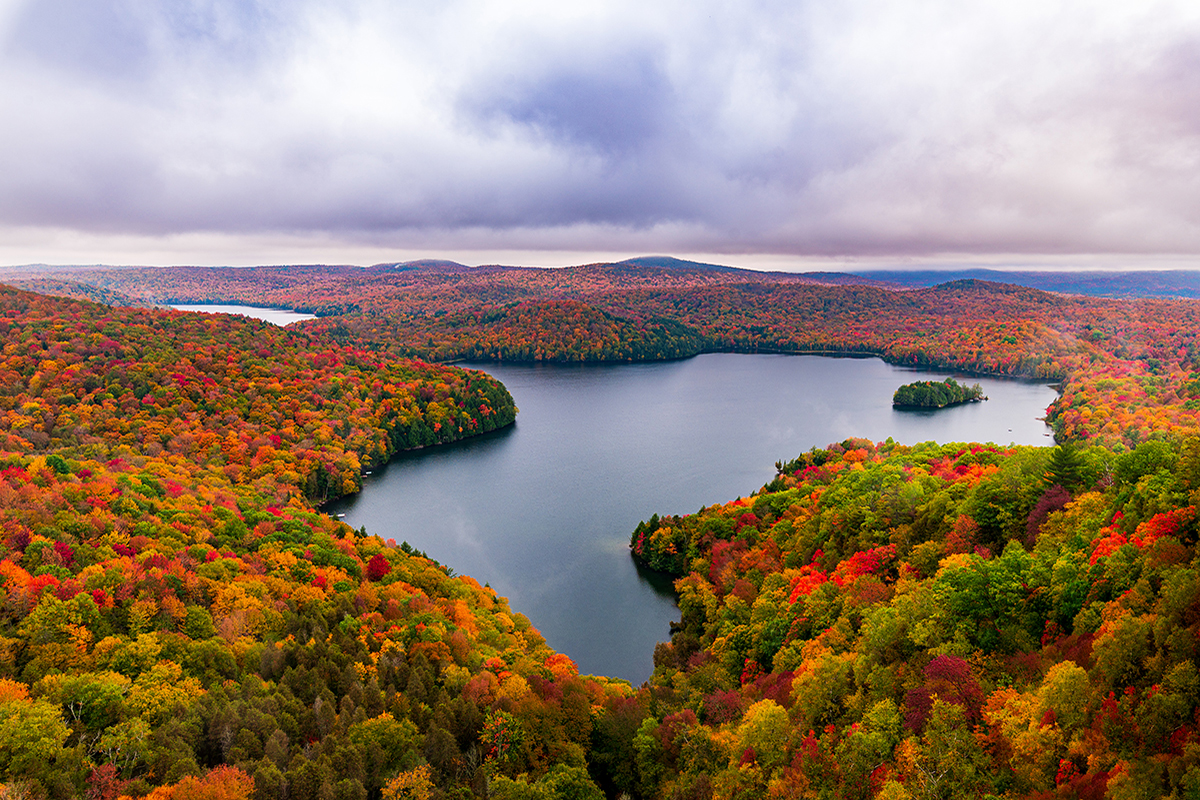Cinematic Centering
With his Tamron SP 24-70mm F/2.8 VC G2 lens, Dino Sokocevic draws inspiration for his fall foliage landscapes from the movies.
Share the article:
More Photo Tips | Video Gallery | Photo Gallery | Enewsletter sign-up
By Jenn Gidman
Images by Dino Sokocevic
When Dino Sokocevic first arrived to the US as a refugee from Bosnia—by way of Croatia and Germany—two decades ago, he was in awe of the scenic landscapes he encountered on hikes and bike rides around his new hometown of Burlington, Vermont. “I was right on the waterfront, with the Adirondacks in New York right across from me,” he says. “I had a small point-and-shoot camera and started taking pictures, and my love of photography snowballed from there.”
After graduating from the University of Vermont with a bachelor’s degree in biology, Dino moved to Salt Lake City, Utah, for grad school to become a physician assistant, got engaged, and bought a house, with an entirely new landscape to explore with his DSLR in the American Southwest. “Whenever I need a break from work and the news, I head outside to take pictures—it’s very relaxing for me,” he says. “I’m an American citizen now, but because I’m not originally from here, I’d always had an idealized infatuation with the Wild West. Now I’m living here, surrounded by red rocks and arches and everything I’d always seen in photos.”
To capture his nature and landscape photos, Dino uses multiple Tamron lenses, but at the moment, his SP 24-70mm F/2.8 VC G2 high-speed zoom lens is his workhorse. “I did a lot of research before buying the 24-70, and this lens offered me the best image quality at a great price point,” he says. “I purchased it right before I visited the Southwest all by myself a few years ago. I was amazed on that trip at the image quality I was achieving, even on the LCD preview. I still have some images from that first excursion hanging in my office. The contrast and sharpness are excellent. The F/2.8 aperture of the 24-70 is key when the light is low, and I rely on the Vibration Compensation (VC) feature to prevent camera shake whenever I’m shooting handheld.”
Wherever he’s wandering, Dino keeps his eye out for scenes that will offer visual drama. “Much of my inspiration comes from the aesthetic of moviemakers like director Stanley Kubrick and cinematographer Roger Deakins, who’s been the director of photography on such films as 1917, Blade Runner 2049, and Skyfall, as well as a slew of movies by the Coen brothers,” he says. “The mood and emotion that comes out of the films—that’s the vibe I’m seeking. I’m also obsessed with center compositions. You’ll see a lot of my images with a centered road or river as a leading line that takes your eye through the image and into its center. That serves as an eye-catching visual journey to me, with a smooth but dynamic flow.”
Read on for tips from Dino on how best to capture the majesty of the autumnal season.
Experiment with different angles and focal lengths for the same scene.
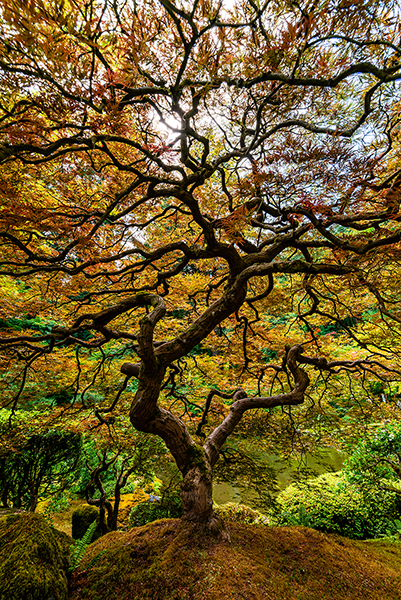
15-30mm (15mm), F/8, 1/100 sec., ISO 100
Click image to view larger
You’d be surprised how much a slight shift in your perspective can dramatically alter how your image comes out. It’s funny, because when you see this gnarly looking tree, located in a Japanese garden in Portland, Oregon, it’s actually only about 6 feet tall. I’m 6 feet tall, so it didn’t look as imposing to me as it does here in this photo. There was a bit of room between the branches where I was able to sneak my camera in to capture the canopy. Using an ultra-wide focal length and a low angle, I was able to make it appear like it’s a 40-foot-high tree, even though it’s only slightly taller than I am.
Tap into the mood of an overcast fall sky.
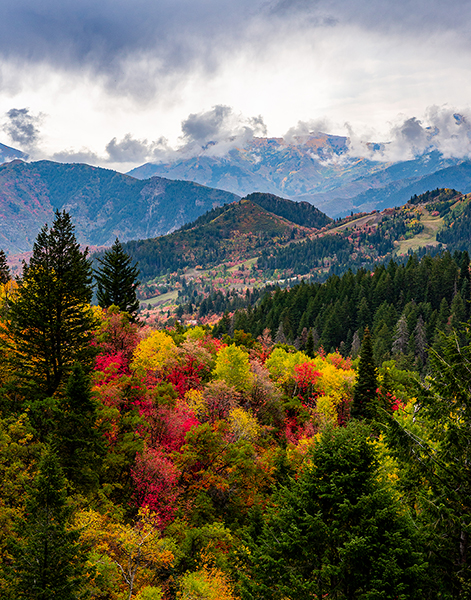
24-70mm (70mm), F/8, 1/640 sec., ISO 400
Click image to view larger
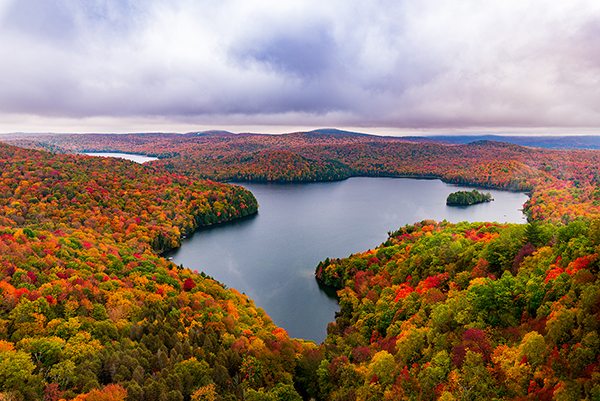
15-30mm (20mm), F/7.1, 1/80 sec., ISO 100
Click image to view larger
I’m of the opinion that perfectly clear autumn skies are awesome for astrophotography and maybe minimalist landscape shots, but generally, those are my least favorite conditions to shoot in. I like a little bit of cloud. That allows you, for example, to do a long exposure to create a more dynamic image.
This first mountain scene, about 30 minutes from my house in Utah, is a prime example of how clouds add some drama to the mood of the photo. You’ve got your focal point of the vibrant fall colors in the foreground, and then the moodier hills and rolling mountains in the background. It’s an appealing contrast. The lake image, which I took in Vermont, also takes advantage of dramatic clouds to accentuate the colors of the trees surrounding the lake, which serves as my center point.
Focus on framing.
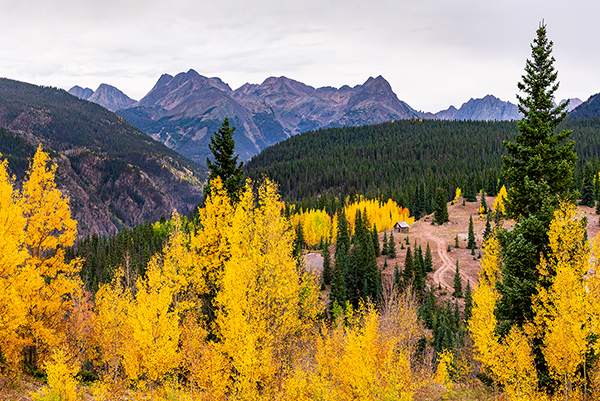
24-70mm (50mm), F/8, 1/200 sec., ISO 400
Click image to view larger
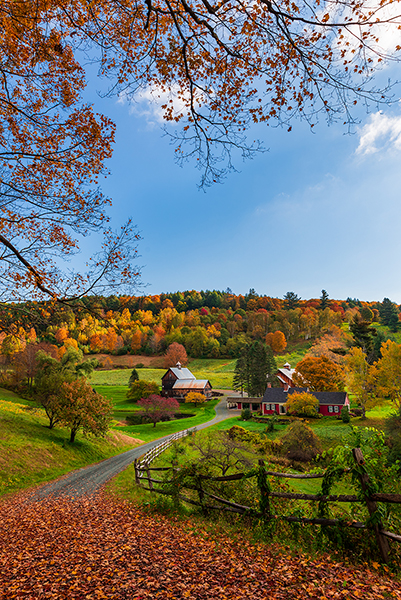
24-70mm (24mm), F/7.1, 1/640 sec., ISO 200
Click image to view larger
In this first photo here taken in Colorado, there’s a lot going on in the scene, from the yellow foliage in the foreground, to the transition to greenery, then back to the mountains. There’s even an unexpected man-made element placed in there: that tiny house, right on the border where the yellow transitions to green.
I do occasionally like to capture a scenario like this; it’s almost like one of those “I Spy” books, where you travel through the image picking out the different elements—“there’s the mountain, there’s the house.” But you want to make sure you’re focused on how you do that, and that’s where framing comes in. I tried to use a modified rule-of-thirds in this photo, where the house appears off to the right a bit, but still somewhat in the center.
This is also another example where, because it’s somewhat of a visual feast, with lots of color and contrast, it’s preferable to have a muted, overcast sky to balance the scene as a whole. If the sky had been any more dynamic, it likely would’ve made the photo too busy.
The next image, taken in Vermont, is one of my favorite classical compositions, one in which I first use the leaves in the foreground to start to pull your eyes down the road, then the leading lines of the road and the fence to draw viewers further into the image. There wasn’t anything interesting on the left side of the frame, however, and I didn’t want the bushes you can’t see to the right to show up in the image. Plus, right in front of me there was a metal fence that didn’t fit the aesthetic of this rustic fall scene. So I had to carefully frame the image in a way so that it became “picture perfect.”
Seek out unusual angles and elements.
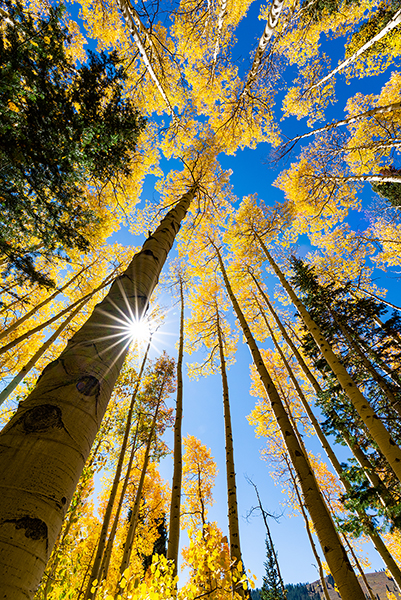
15-30mm (15mm), F/16, 1/400 sec., ISO 200
Click image to view larger
Back on the East Coast, we don’t have aspens, but out West, they’re featured quite often in fall foliage photos. They’re relatively new to me and still look kind of similar to my eye, so for this photo, I tried for a super-low angle, gazing skyward. I mentioned before how I don’t typically prefer clear skies, but when you have the yellow of the aspens juxtaposed against that brilliant blue like this, it can lend itself to a compelling visual.
And when I’ve got clear skies like this, I’ll often look to incorporate sunbursts, because they look cool, and because the light is usually more dramatic and direct. I’ll set my aperture somewhere around F/16—the tighter your aperture is closed, the more sunbursts you can get. Then I’ll rock back and forth an inch or two where I’m sitting, until I obfuscate the sun behind one of the trees just enough, so there’s just a pinpoint of light visible. When I press the shutter button, it transforms into a sunburst.
Use repetition to control the chaos and bring balance.
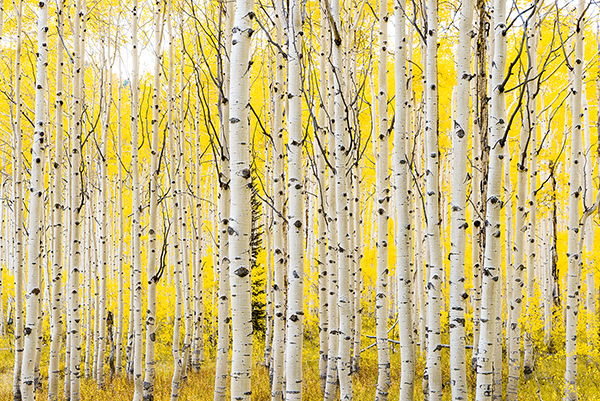
24-70mm (62mm), F/5.6, 1/40 sec., ISO 280
Click image to view larger
For this photo of the aspens in Utah, I used that center-style composition again. It can sometimes be hard to find a visual anchor in a landscape like this, but the image essentially boiled down to the blacks, whites, and yellows of the scene, so that’s what I wanted to focus on. By framing the trees so that they were all uniformly straight, almost like bars placed upon a background of yellow, it pulled everything together into a cohesive whole.
Take advantage of early snowfall.
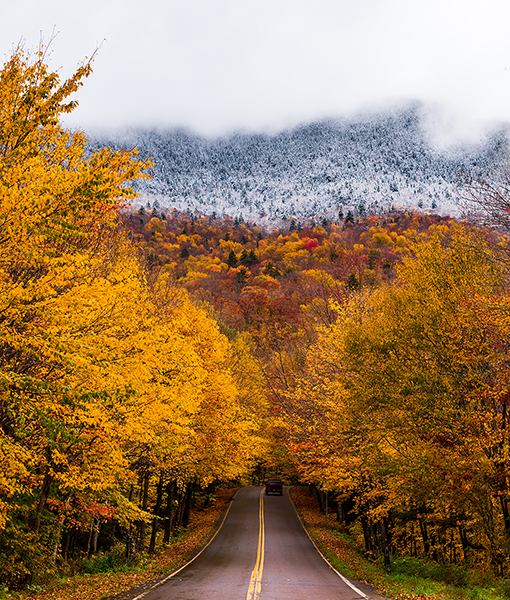
24-70mm (70mm), F/8, 1/100 sec., ISO 200
Click image to view larger
The crowning achievement of nature photographers trying to take autumn landscape photos is to capture the colorful fall foliage either dusted with snow, or against a backdrop of it. In this image taken along a country road in Vermont, fresh snow had fallen further up the mountain about an hour prior to me taking the photo. The leading line of the road at the bottom of the frame offers the feeling that whoever’s in that car is about to drive into the thick of it, from one season into the next.
That center composition, rule-of-thirds, and framing I mentioned earlier come into play here as well. The photo is more or less broken up into thirds, with the car and roadway on the bottom third, the fall foliage taking up the middle third, and the snow-dusted landscape taking up the top third. And while you can’t see it here, there’s a parking lot just off to my right. The image imparts a feeling of remoteness, but that’s only because I framed it to cut out the distracting parking lot.
To see more of Dino Sokocevic’s work, check out his Instagram.
More Photo Tips | Watch Videos | Learn More About Tamron Lenses | Photo Gallery
